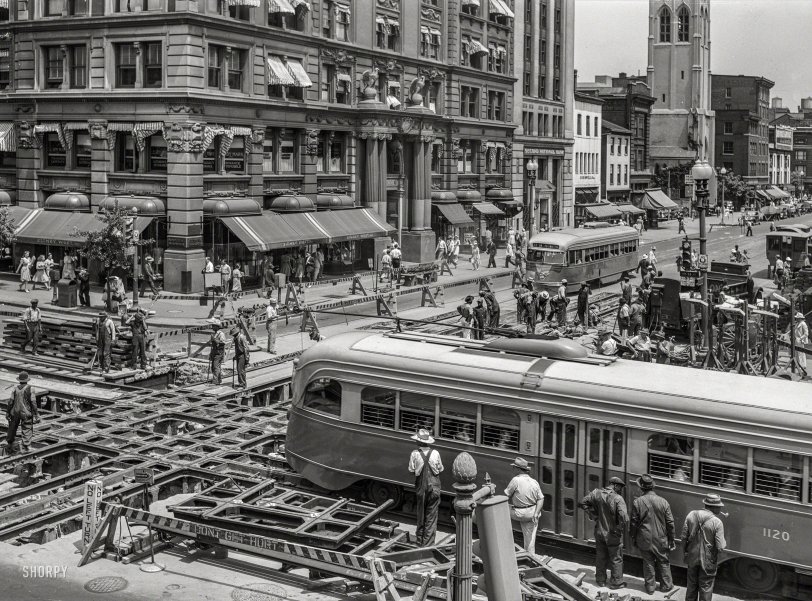


Framed or unframed, desk size to sofa size, printed by us in Arizona and Alabama since 2007. Explore now.
Shorpy is funded by you. Patreon contributors get an ad-free experience.
Learn more.

- Baldwin 62303
- Baldwin VO-1000
- Cold
- No expense spared
- Tough Guys
- Lost in Toyland
- And without gloves
- If I were a blindfolded time traveler
- Smoke Consumer Also Cooks
- Oh that stove!
- Possibly still there?
- What?!?
- $100 Reward
- Freeze Frame
- Texas Flyer wanted
- Just a Year Too Soon
- WWII -- Replacing men with women at the railroad crossing.
- Yes, Icing
- You kids drive me nuts!
- NOT An Easy Job
- I wonder
- Just add window boxes
- Icing Platform?
- Indiana Harbor Belt abides
- Freezing haze
- Corrections (for those who care)
- C&NW at Nelson
- Fallen Flags
- A dangerous job made worse
- Water Stop
Print Emporium
Urban Infrastructure: 1941

July 1941. "Work on streetcar tracks, Fourteenth and G Streets N.W., Washington, D.C." Medium format negative by Martha McMillan Roberts. View full size.
Sleep cars
The street car was half a block from my house. They would put me to sleep. My grandma would set me on the hot box near the center of the streetcar. Winters were great, but summers made for a very hot rear.
Lots of old friends
Many familiar fac(ad)es here.
Dominating the background is the Colorado Building, which we previously saw from the inside.
Further east is Epiphany Church, now with a taller bell tower.
At far right is a glimpse of Jordan Piano Co. (13th & G NW, northeast corner), seen to better advantage in an earlier Shorpy post.
Under the Asphalt
I wonder how much steel was left in these streets as most of the tracks were not removed, but merely asphalted over.
Don't Get Hurt!
I see no hi-viz vests, no hard hats, and doubtless no steel toed boots on the workmen. Thank goodness the wooden crossbucks surrounding the work zone contain the admonitions "Safety First" and, more importantly, "Don't Get Hurt!"
Plow pit
Overhead wires were not allowed in most of Washington. It made for cleaner views but the resulting plow pits certainly complicated track work.
Capital Transit 1120
Capital Transit Company 1120 was an Electric Railway President's Conference Committee or “PCC car” built in 1937 by the St. Louis Car Company. It was one of Capital Transit's initial order for 45 PCC cars. By 1946, Capital Transit would operate a fleet of 489 PCC cars. That cars were being built for Capital Transit during World War II shows just how important Washington's street car system was to the war effort.
Washington PCC cars were one window shorter than standard PCC car because of transfer table clearances. They were also the only PCC cars ever equipped for underground conduit operations, as can be noted by the trolley pole in the “retrieved” position. Washington's streetcar system used underground conduits in the heart of the city but switched to overhead lines as the routes left the downtown area.
It took a few minutes to make the transition. An inbound car would pull over a “plow pit” in the middle of the street where one worker would lower the trolley pole and another, working in the pit under the car, would attach the “plow,” the device which hung from a truck of the car, through the slot in the street between the rails, and made contact with the conductor rails under the street. For outbound cars the procedure was reversed. After WWII, Capital Transit developed an automatic device for raising and lower the pole without the need of the “trolleyman.”
This photograph clearly shows just how complicated the conduit system was. There would have been dead spots in a crossing such as this and a street car would have to coast through it. If a motorman had to stop a car in the intersection to avoid hitting an automobile, it would not have any power and would need to wait for a following car to push it through the intersection. This would cause delays for the streetcar and its passengers and congestion for automobile traffic.
74 Washington PCC cars went to Sarajevo, Yugoslavia in 1959-1962 and 101 cars went to Barcelona, Spain in 1962-1963 but 1120 was not one of them.
























On Shorpy:
Today’s Top 5